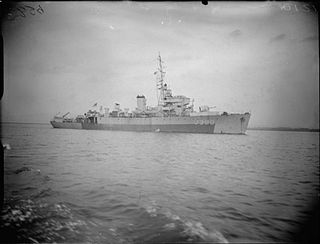
HMS Raider was a R-class destroyer built for the Royal Navy during the Second World War.
HMS Rye (J76) was a Bangor-class minesweeper built for the Royal Navy during the Second World War.

HMS Halcyon was the lead ship in her class of minesweepers built for the Royal Navy in the 1930s. The vessel was launched on 20 December 1933 and was used as a convoy escort and during the landing operations during the invasion of Normandy during World War II. The ship was sold for scrapping in 1950.

HMS Carnarvon Bay was a Bay-class anti-aircraft frigate built for the Royal Navy during World War 2.

HMS Scourge was an S-class destroyer built for the Royal Navy during the Second World War. The ship was sold to the Netherlands postwar, where it saw action in the Korean War and the West New Guinea dispute.

HMS Racehorse was a R-class destroyer built for the Royal Navy during the Second World War.

HMS Redoubt was an R-class destroyer built for the Royal Navy during the Second World War.

HMS Clacton was a Bangor-class minesweeper built for the Royal Navy during the Second World War.
HMS Felixstowe was a Bangor-class minesweepers built for the Royal Navy during the Second World War.
HMIS Kathiawar (J155) was a Bangor-class minesweeper built for the Royal Navy, but transferred to the Royal Indian Navy (RIN) during the Second World War.
HMIS Baluchistan (J182) was a Bangor-class minesweeper built for the Royal Navy, but transferred to the Royal Indian Navy (RIN) during the Second World War.
HMIS Khyber (J190) was a Bangor-class minesweeper built for the Royal Navy, but transferred to the Royal Indian Navy (RIN) during the Second World War.
HMIS Kumaon (J182) was a Bangor-class minesweeper built for the Royal Navy, but transferred to the Royal Indian Navy (RIN) during the Second World War.
HMIS Carnatic (J182) was a Bangor-class minesweeper built for the Royal Navy, but transferred to the Royal Indian Navy (RIN) during the Second World War.

HMS Loyal was a L-class destroyer built for the Royal Navy in the late 1930s, although she was not completed until after World War II had begun.
HMS Lyme Regis was a Bangor-class minesweeper built for the Royal Navy during the Second World War.

HMS Fly (J306) was a reciprocating engine-powered Algerine-class minesweeper during the Second World War. She survived the war and was sold to Iran in 1949 as IISPalang.

HMS Jewel (J390) was a steam turbine-powered Algerine-class minesweeper during the Second World War.

HMS Lennox (J276) was a reciprocating engine-powered Algerine-class minesweeper during the Second World War.

HMS Onyx (J221) was a steam turbine-powered Algerine-class minesweeper during the Second World War.











